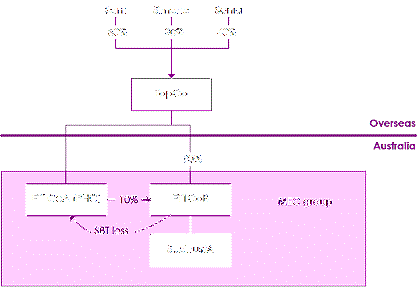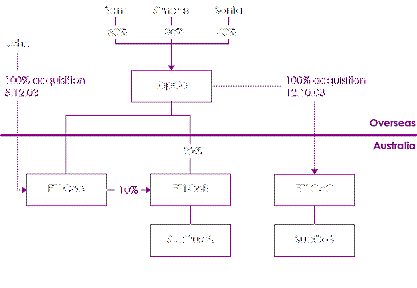Consolidation Reference Manual
You can still refer to the Consolidation reference manual for consolidation information that has not been impacted by changes in the legislation.
C10 MEC groups
C10-2 Worked example
Losses
C10-2-392 Assumptions about the test company failing the COT - MEC group ceases to exist because there ceases to be a provisional head company
Description
This example outlines a case in which the test company is deemed to have failed the continuity of ownership test (COT). Specifically, it illustrates a case where a MEC group ceases to exist because there ceases to be a provisional head company. → 'MEC groups and losses - determining whether the focal company satisfies the continuity of ownership test', C10-2-325
Commentary
In recognition of the special characteristics of MEC groups, Subdivision 719-F of the Income Tax Assessment Act 1997 (ITAA 1997) modifies the rules about transferring and utilising losses within those groups.
The focal company (the company seeking to utilise the loss) is considered to have met the continuity of ownership conditions in section 165-12 of the ITAA 1997 if the test company would have met those conditions based on the assumptions in sections 719-270, 719-275 and 719-280. [1]
Under section 719-280, the test company is deemed to have failed the COT (section 165-12) in relation to a loss in certain circumstances. Broadly, those circumstances are where one of the following events happens to the focal company's MEC group, or potential MEC group, after the start of the focal company's ownership test period for the loss: [2]
- •
- the potential MEC group ceases to exist
- •
- the potential MEC group continues to exist but the identity of the top company changes as a result of the acquisition of membership interests in certain entities below the group's original top company (the relevant entities are the group's eligible tier-1 companies or any entities interposed between the eligible tier-1 companies and the original top company), or
- •
- there ceases to be a provisional head company for the group.
The test company will also fail the conditions in section 165-12 where those conditions are not met based on the assumptions in section 719-270 and section 719-275. Where this actual COT failure occurs in addition to a deemed COT failure (under section 719-280), the COT failure time will be the earlier of the two. Under section 719-260, the focal company is considered to have failed to meet a condition in section 165-12 only at the first time that the test company would have failed to meet the condition.
Example
Facts
TopCo is a foreign-resident company that owns all of the membership interests in ET1CoA, an Australian-resident company. TopCo also owns 90% of the membership interests in Australian-resident company ET1CoB, with the remaining interests being owned by ET1CoA. ET1CoB in turn is the sole beneficiary of Australian resident fixed trust SubTrustA.
As shown in figure 1, a MEC group forms on 1 July 2002, consisting of SubTrustA and the eligible tier-1 companies ET1CoA and ET1CoB. ET1CoA is appointed as the provisional head company. [3] On that date, TopCo's shares are held by Sam (30%), Simone (30%) and Sonia (40%). These membership interests are held continuously from 1 July 2002 to 30 June 2005.
At formation, a loss made by ET1CoB for the income year ending 30 June 2002 (hereafter referred to as the 'SBT loss') is transferred to ET1CoA because ET1CoB satisfies the SBT. ET1CoA is the provisional head company at the end of the income year in which the loss is transferred and is therefore treated as the head company of the MEC group for that income year. → section 719-75
On 12 October 2003, TopCo acquires all of the membership interests in ET1CoC, an Australian resident company that then qualifies as an eligible tier-1 company of TopCo (figure 2). ET1CoC owns all of the membership interests in the Australian-resident company SubCoB.
A choice is made for ET1CoC to become a member of the MEC group. [4] As a result, SubCoB also becomes a member of the MEC group. [5]
On 5 December 2003, John purchases 100% of the membership interests in ET1CoA. As a result, ET1CoA, ET1CoB and SubTrustA cease to be members of the MEC group. ET1CoC is ineligible to be a provisional head company because it has not been a member of the MEC group since the start of the income year → subsection 719-65(3). Also, SubCoB cannot be nominated as the replacement provisional head company as it is not an eligible tier-1 company of the top company, TopCo → subsection 719-65(1). Therefore, the MEC group ceases to exist. [6]
ET1CoA seeks to utilise the transferred SBT loss in the income year ending 30 June 2005.
Figure 1: MEC group at formation (1 July 2002)

Figure 2: Post-formation changes in membership interests

Calculation
ET1CoA, the focal company, will be considered to have satisfied the continuity of ownership conditions in section 165-12 if the test company would have met those conditions based on the assumptions in sections 719-270, 719-275 and 719-280. In addition to establishing whether there has been a deemed COT failure under section 719-280 (step 5 below), it is also necessary to determine whether the COT has been satisfied in relation to the assumptions set out in sections 719-270 and 719-275 (steps 1 to 4 below).
Step 1: Identify the test company
Applying section 719-265, TopCo is the test company.
Item 1 in the table in subsection 719-265(3) applies as the loss was transferred because the same business test was satisfied and ET1CoA (the focal company) was the head company of the MEC group at the time of the transfer. TopCo is the test company because it was the top company of the MEC group at the transfer time.
In this example, ET1CoA is the focal company because it is the company that seeks to utilise the loss.
Step 2: Assume that the test company made the loss
Applying section 719-270, TopCo is considered to have made the loss.
Subsection 719-270(1) applies as TopCo (the test company) was the top company of the MEC group and ET1CoA (the focal company) was the head company of the MEC group.
Step 3: Identify the start of the income year for which the test company is taken to have made the loss
Applying section 719-270, TopCo is assumed to have made the loss for an income year starting on 1 July 2002.
Item 2 in the table in subsection 719-270(1) applies because ET1CoA (the focal company) made the loss because it was transferred to it under Subdivision 707-A. Under this item, the test company (TopCo) is taken to have made the loss for an income year starting at the time of transfer (in this case, 1 July 2002).
Step 4: Apply the COT to the test company ignoring ownership and voting changes below the top company level
Section 719-275 does not apply. Therefore, there are no assumptions that apply for section 165-12 purposes in relation to 'freezing' the ownership structure below the top company.
Taking into account the assumptions in section 719-270, the test company, TopCo, passes the COT. It satisfies the conditions in section 165-12 because 100% of TopCo's ownership remains constant from 1 July 2002 (the start of the income year in which TopCo is taken to have made the loss) to 30 June 2005 (the end of the loss claim year).
However, TopCo will fail to satisfy the conditions in section 165-12 if the deemed COT failure in section 719-280 applies.
Step 5: Determine whether the deemed COT failure applies
Section 719-280 applies to deem the test company, TopCo, to fail the continuity of ownership conditions in section 165-12 because a specified 'failing' event in subsection 719-280(4) occurs on 5 December 2003, which is after the start of ET1CoA's (the focal company's) ownership test period (1 July 2002). [7] The specified 'failing' event in this instance is the cessation of the MEC group that occurred because there ceased to be a provisional head company of the group.
Step 6: Determine whether the focal company meets the conditions in section 165-12
Under subsection 719-260(1), the focal company is considered to meet the continuity of ownership conditions in section 165-12 if the test company meets those conditions (based on the relevant assumptions).
In this case, therefore, the focal company, ET1CoA, does not meet the conditions in section 165-12 because the test company, TopCo, does not meet those conditions based on all the assumptions in sections 719-270, 719-275 and 719-280. In particular, TopCo fails to meet the conditions in section 719-280.
ET1CoA is considered to have failed the conditions in section 165-12 on 5 December 2003, at the time that TopCo is deemed to have failed them based on the assumptions in section 719-280.
References
Income Tax Assessment Act 1997:
- •
- section 165-12
- •
- Subdivision 719-A
- •
- section 719-140 ; as inserted by Tax Laws Amendment (2010 Measures No. 1) Act 2010 (No. 56 of 2010), Schedule 5, Part 2
Explanatory Memorandum to the New Business Tax System (Consolidation) Bill (No. 1) 2002, Chapter 4
Income Tax Assessment Act 1997 , Subdivision 719-F; as amended by New Business Tax System (Consolidation and Other Measures) Act 2003 (No. 16 of 2003), Schedule 13
Tax Laws Amendment (2010 Measures No. 1) Act 2010 , item 17
Explanatory Memorandum to Tax Laws Amendment (2010 Measures No. 1) Bill 2010, paragraphs 5.92, 5.105 and 5.106
History
Revision History
Section C10-2-392 first published 2 October 2003.
Further revisions are described below:
| Date | Amendment | Reason |
|---|---|---|
| 6.5.11 | New footnote p. 1.
Minor amendments to footnotes p. 2. |
Legislative amendment. |
Current at 6 May 2011
The assumptions contained in sections 719-270 and 719-275 relate to determining whether the test company has satisfied the COT. If the conditions in section 719-280 are satisfied, however, the test company is deemed to have failed the COT.
Section 719-280 does not apply where the event occurs because the MEC group has converted to a consolidated group, where the conversion to a consolidated group took place:
- •
- on or after 27 October 2006; or
- •
- before 27 October 2006 and a choice is made within the prescribed time for Subdivision 719-BA to apply from 1 July 2002.
→ section 719-140, item 17, Tax Laws Amendment (2010 Measures No.1) Act 2010; paragraphs 5.92, 5.105 and 5.106, Explanatory Memorandum to Tax Laws Amendment (2010 Measures No. 1) Bill 2010
Under subsection 719-60(1), the appointment of a provisional head company must be included in the notice of choice to form a MEC group made under section 719-50.
Subsection 719-5(4) allows the provisional head company of a MEC group to elect for certain entities that become eligible tier-1 companies of a pre-existing MEC group to become members of the MEC group.
SubCoB satisfies the requirements in the table in subsection 719-10(1), which in conjunction with subsection 719-5(4) means that it qualifies as a member of the MEC group.
Under subsection 719-5(7), a MEC group ceases to exist where there ceases to be a provisional head company of the group.
As the focal company, ET1CoA, made the loss because of a transfer under Subdivision 707-A, section 707-205 has the effect that the ownership test period for ET1CoA starts at the time of the transfer (i.e. 1 July 2002).
